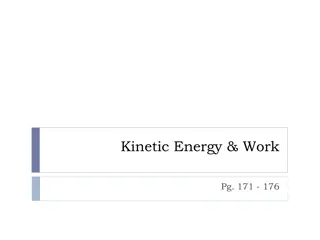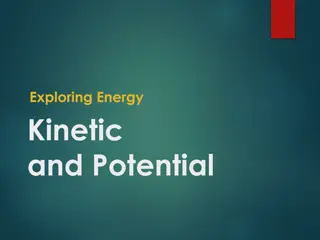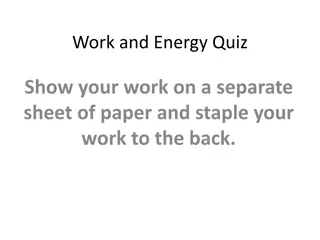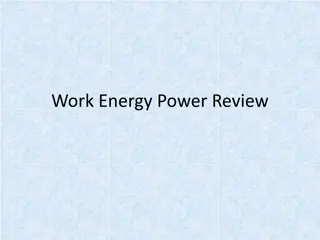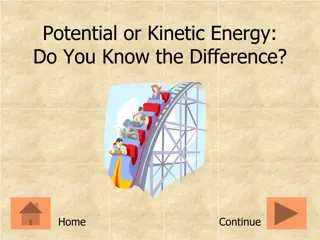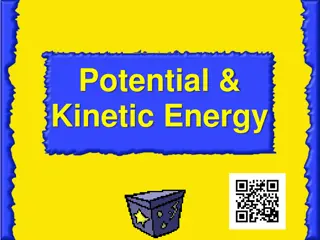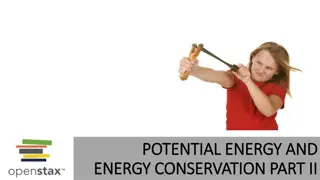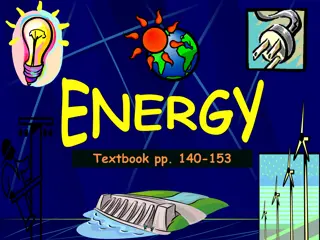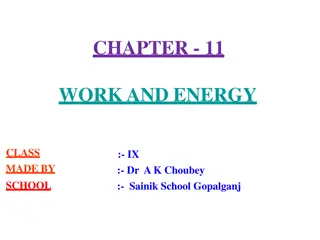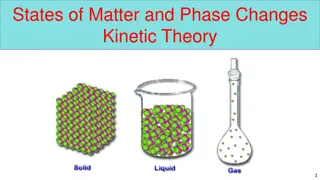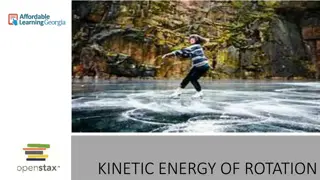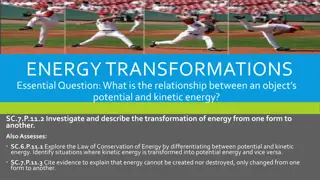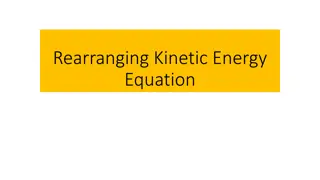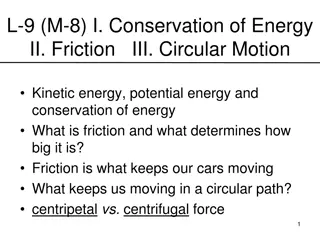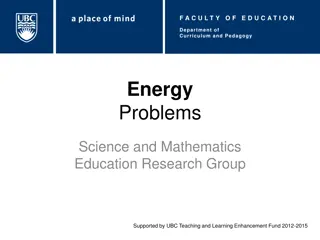Understanding Potential and Kinetic Energy in Physics Lectures
Delve into the world of potential and kinetic energy through lectures by Dr. Sharafudeen K.N and Dr. Vijayakumar S. Explore concepts like gravitational potential energy, conservation of mechanical energy, and how energy applies to bungee jumping. Learn about the work done by gravity, the interplay of forces, and the conservation of energy in various scenarios.
Download Presentation

Please find below an Image/Link to download the presentation.
The content on the website is provided AS IS for your information and personal use only. It may not be sold, licensed, or shared on other websites without obtaining consent from the author. Download presentation by click this link. If you encounter any issues during the download, it is possible that the publisher has removed the file from their server.
E N D
Presentation Transcript
Potential Energy and Energy Conservation Lectures by Dr Sharafudeen K N Lectures by Dr Vijayakumar S 1
Outline Gravitational potential energy Conservation of mechanical energy Conservation of energy: (a)when gravity only does work (b)when forces other than gravity do work Elastic potential energy Situations with both gravitational and elastic forces Conservative and non-conservative forces Conservation of energy 2
Physics of bungee jumping How do energy concepts apply to the bungee jumper? Yes, gravity does work and kinetic energy (KE) increases when he comes down or we can think of energy as being stored and transformed from one form to another Energy associated with position of a system is called Potential Energy (PE). PE associated with a body s weight and height above the ground is called gravitational PE (Ugrav). 3
Gravitational potential energy Work done by gravity to move the body to the ground, Fg = mg Wgrav =Fs cos = mg.y.1= mgy y Gravitational PE associated with a body, Ugrav = mgy 4
Gravitational potential energy Work done by gravitational force to make a displacement from y1 to y2, ?????= ???1 ???2= ?????,1 ?????,2 ?????= ????? Reason for the -ve sign, when the body moves up, work done by gravity is negative and the gravitational PE increases when the body moves down, gravity does positive work, and the gravitational PE decreases 5
Conservation of mechanical energy: when gravity only does work The total mechanical energy of a system is the sum of its kinetic energy and potential energy. A quantity that always has the same value is called a conserved quantity. When only the force of gravity does work on a system, the total mechanical energy of that system is conserved. ?? ???? ??????? ????? ?? ? ? ??????, ? ?? ?? ??? ? ? ???? ?????? ???????, ? ? ????? ???? ???? ?? ? ? ???? ?? ? ? ? ???? ?? ?? ?? ? ? ???? That is, ?????= ? ?????,1 ?????,2= ?2 ?1 ?????,1+ ?1= ?????,2+ ?2 ? + ? = ????????= E 6
Conservation of energy: when gravity only does work E = U + K ENERGY Variation of K, U and E with height of a body above the ground K U h=0 h HEIGHT (ABOVE REFERENCE LEVEL) 7
Conservation of energy: when forces other than gravity do work ????? + ??? ??= ?2 ?1 ?1+ ?????,1 + ??? ??= ?2+ ?????,2 The work done by all forces other than the gravitational force equals the change in the total mechanical energy E of the system F other displacement a) when ??? ?? is positive, E increases b) when ??? ?? is negative, E decreases 8
Energy in projectile motion Two identical balls leave from the same height with the same speed but at different angles. When the path is slanted or curved, work done by gravity is the same as though the body had been displaced vertically to a distance without any horizontal displacement Thus the speed of a projectile at a given elevation h is always the same, if we ignore air resistance 9
Elastic potential energy A body is elastic if it returns to its original shape after being deformed. Elastic potential energyis the energy stored in an elastic body, such as a spring. The elastic potential energy stored in an ideal spring is ???=? ???? 10
Elastic potential energy Figure at the right shows a graph of the elastic potential energy for an ideal spring ???+ ? = ?,?? ????????? It can explain 1. how a car reacts to ground on its suspension 2. the strength of a bungee jump rope so that there is safe landing 11
Situations with both gravitational and elastic forces When a situation involves both gravitational and elastic forces, the total potential energy is the sum of the gravitational potential energy and the elastic potential energy ????= ?????+ ??? The work done by all forces other than the gravitational force or elastic force equals the change in the total mechanical energy E (=U+K) of the system 12
Conservative and non-conservative forces A conservative between kinetic and potential energy. Gravity and the spring force are conservative force allows conversion The work done between two points by any conservative force: a) can be expressed in terms of a potential energy function b) is reversible c) is independent of the path between the two points d) is zero if the starting and ending points are the same A force (such as friction) that is not conservative is called a non-conservative force, or a dissipativeforce 13
Conservation of energy Nonconservative forces do not store potential energy, but they do change the internal energyof a system. The law of the conservation of energy means that energy is never created or destroyed; it only changes form. This law can be expressed as ? + ? + ????= 0 14
Calculation with elastic potential energy A glider with mass m=0.200 kg sits on a frictionless, horizontal air track, connected to a spring with force constant k= 5.00N/m. You pull on the glider, stretching the spring 0.100m, and release it from rest. The glider moves back toward its equilibrium position (x=0). What is its x-velocity when x = 0.080 m? As the glider start to move, elastic potential energy is converted to kinetic energy. Here only spring force does work on the glider, so Wother =0 and hence conservation of energy sets, E= Uel+ K= constant ?2= ?1+ ?1 ?2 ? = ?.?? ?/? 15
Thank You 16





